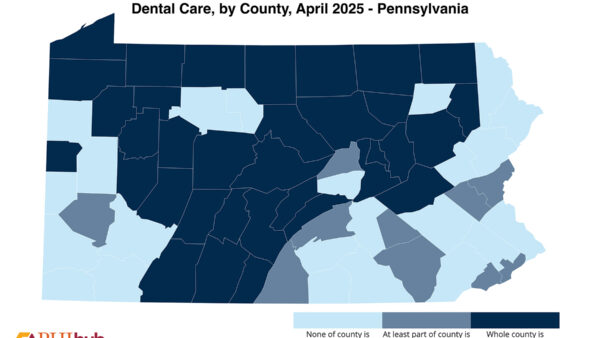
TAMAQUA – A severe dental care crisis in rural Pennsylvania is causing life-threatening health issues, according to testimony from a public hearing of the Senate Majority Policy Committee chaired by Sen. Dave Argall (R-29) today. The committee reviewed many different strategies to encourage more dentists and other professionals to practice in small towns, cities, and townships, including Temple University’s proposed rural dental school in Tamaqua, the first of its kind in Pennsylvania.
“This is literally a choice of life or death,” said Argall. “A lack of regular dental care increases rates of opioid abuse, contributes directly to heart disease, results in people missing work, and can cause a whole host of other nasty issues. The future looks bleak unless we do something now.
“Today, we learned that the Temple University School of Dentistry and the Tamaqua Area Community Partnership will locate Pennsylvania’s first rural dental school in Tamaqua. State Representative Jamie Barton, Congressman Dan Meuser, and I look forward to working with them to finalize all the details and the sooner, the better.”
“Dental problems are the leading cause of missed school days and can negatively impact nutrition, sleep, and speech and self-esteem for our children,” said Barton. “Likewise, oral infections, especially in rural areas like ours where access is limited, very often become medical emergencies costing significantly more than treatment in a regular dental office. Having a dental school and clinic in Tamaqua will fill the gaps in rural dentistry here in Schuylkill County and throughout the Commonwealth.”
The committee listened to three hours of testimony from dental professionals, colleges and universities, and other stakeholders.
Dr. Amid Ismail, the dean of the Kornberg School of Dentistry at Temple University, discussed the model for the new dental school in Tamaqua, which he predicted will open in September of 2026. Twenty students each year would complete their final two years of dental school at the Tamaqua clinic, providing care to patients from Schuylkill, Carbon, and Luzerne counties. Student apartments will be located within walking distance of the school.
Jessica Brennan, a public health dental hygiene practitioner at St. Luke’s Primary Care and Dental in Tamaqua, shared her day-to-day experiences, noting that “we’ve had children with abscesses miss school because no one could see them. We’ve had elderly patients with broken teeth or dentures forced to give up meals they love or go on soft diets. These are not rare cases; they’re weekly occurrences. This is the reality of rural dentistry in Pennsylvania.”
She also shared how the overwhelming demand for dental services has left her clinic unable to treat everyone. Their part-time dentist is booked out two years for basic care appointments and the clinic can no longer accept new patients. They receive over 100 calls a month from individuals in dental pain.
“I was shocked to hear stories today that sounded more like 1825 than 2025,” said Argall. “I understood that George Washington had painfully bad teeth 250 years ago, but I thought we had made more progress.”
Dr. Marie Tacelosky of Mahanoy City, who represented the Pennsylvania Dental Association, shared that from 2019-2022, Pennsylvania ranked 48th nationwide with a -9% net migration of dentists. Dr. Joan Gluch, the associate dean for academic policies at the University of Pennsylvania School of Dental Medicine, noted that this decrease has especially affected rural areas. From 2015-21, rural counties experienced a 14.2% decrease in licensed dentists, while urban counties lost 3.5%. These trends are not expected to reverse without intervention – over 22% of Pennsylvania dentists are aged 65 and older, and over 18% of dental hygienists are 60 or older.
Dr. Karen Rainey, the director of the Dental Health Department at Luzerne County Community College, called for a new dental school in rural Pennsylvania, saying “currently all three dental schools in Pennsylvania are in large metropolitan areas. But a dental school in northeastern or central Pennsylvania whose mission would be to improve dental care in underserved areas could help educate future dentists who will return to their hometown to serve their neighbors.” She discussed how this would address one of the biggest barriers to addressing this shortage: “when students can learn and work in their own communities, they’re far more likely to stay and serve in those communities.”
The impact of dental care shortages was outlined in dire terms. The Hospital and Healthsystem Association of Pennsylvania stated that “poor oral health is directly linked to a range of serious medical conditions that hospitals are tasked with treating, including cardiovascular disease, diabetes complications, adverse pregnancy outcomes, and infections that can rapidly spread if left untreated.” Emergency rooms frequently become the safety net. About 2 million hospital visits per year are due to oral issues that could be prevented with regular dental care. These visits “drain resources from already strained rural hospitals and undermine their ability to meet broader community health needs.”
According to data from the U.S. Health Resources and Services Administration, 37 of Pennsylvania’s 67 counties are designated as shortage areas, including Schuylkill and Luzerne counties. The 2023 Pennsylvania Dentist Workforce Study Report found that 17.9% of dentists practice in rural areas, while 82.1% practice in urban areas.
Helen Hawkey, the executive director of the Pennsylvania Coalition for Oral Health, stated that no other reforms matter if there are not enough dental professionals. According to their review of the dental care workforce, Pennsylvania needs 2,000 dentists, 7,000 dental hygienists, and 10,000 expanded function dental assistants to provide every person with regular dental care.
“This is not a crisis we can ignore,” said Argall. “We must find a sustainable solution before this problem worsens. Establishing a rural dental school here will make our families, friends, and neighbors healthier for decades to come.”
The full hearing and testimony are available on the Senate Majority Policy Committee’s website.
CONTACT: Jim Brugger
